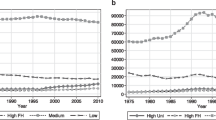Abstract.
The recent economic literature on the incidence of various forms of post-secondary on-the-job and off-the-job training in Germany and the United States, as well as on the effects of training on wages, inequality, and labor mobility is surveyed. Young workers in Germany receive substantially more company-based (apprenticeship) training than United States workers. In the United States, high turnover deters firms from investing in general skills while it results in improved job matches. The received literature consents that key institutional elements required to make the German apprenticeship system work are absent in the United States.
JEL classification: I2, J3, J24
Similar content being viewed by others
Author information
Authors and Affiliations
Additional information
Received December 14, 1995 / Accepted February 19, 1996
Rights and permissions
About this article
Cite this article
Winkelmann, R. How young workers get their training: A survey of Germany versus the United States . J Popul Econ 10, 159–170 (1997). https://doi.org/10.1007/s001480050036
Issue Date:
DOI: https://doi.org/10.1007/s001480050036




